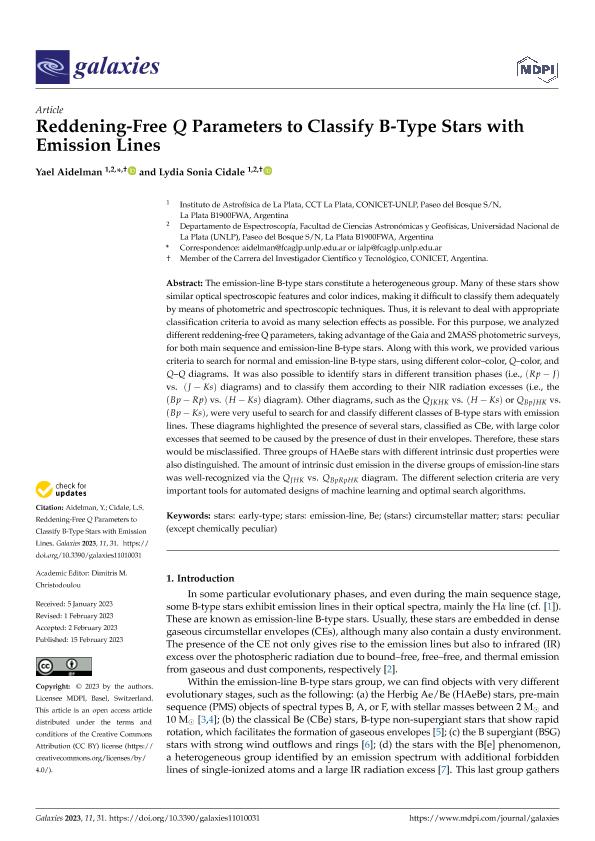Mostrar el registro sencillo del ítem
dc.contributor.author
Aidelman, Yael Judith

dc.contributor.author
Cidale, Lydia Sonia

dc.date.available
2024-04-19T10:14:18Z
dc.date.issued
2023-02
dc.identifier.citation
Aidelman, Yael Judith; Cidale, Lydia Sonia; Reddening-Free Q Parameters to Classify B-Type Stars with Emission Lines; MDPI; Galaxies; 11; 1; 2-2023; 1-22
dc.identifier.issn
2075-4434
dc.identifier.uri
http://hdl.handle.net/11336/233505
dc.description.abstract
The emission-line B-type stars constitute a heterogeneous group. Many of these stars show similar optical spectroscopic features and color indices, making it difficult to classify them adequately by means of photometric and spectroscopic techniques. Thus, it is relevant to deal with appropriate classification criteria to avoid as many selection effects as possible. For this purpose, we analyzed different reddening-free Q parameters, taking advantage of the Gaia and 2MASS photometric surveys, for both main sequence and emission-line B-type stars. Along with this work, we provided various criteria to search for normal and emission-line B-type stars, using different color–color, Q–color, and Q–Q diagrams. It was also possible to identify stars in different transition phases (i.e., (Formula presented.) vs. (Formula presented.) diagrams) and to classify them according to their NIR radiation excesses (i.e., the (Formula presented.) vs. (Formula presented.) diagram). Other diagrams, such as the (Formula presented.) vs. (Formula presented.) or (Formula presented.) vs. (Formula presented.), were very useful to search for and classify different classes of B-type stars with emission lines. These diagrams highlighted the presence of several stars, classified as CBe, with large color excesses that seemed to be caused by the presence of dust in their envelopes. Therefore, these stars would be misclassified. Three groups of HAeBe stars with different intrinsic dust properties were also distinguished. The amount of intrinsic dust emission in the diverse groups of emission-line stars was well-recognized via the (Formula presented.) vs. (Formula presented.) diagram. The different selection criteria are very important tools for automated designs of machine learning and optimal search algorithms.
dc.format
application/pdf
dc.language.iso
eng
dc.publisher
MDPI
dc.rights
info:eu-repo/semantics/openAccess
dc.rights.uri
https://creativecommons.org/licenses/by/2.5/ar/
dc.subject
(STARS:) CIRCUMSTELLAR MATTER
dc.subject
STARS: EARLY-TYPE
dc.subject
STARS: EMISSION-LINE, BE
dc.subject
STARS: PECULIAR (EXCEPT CHEMICALLY PECULIAR)
dc.subject.classification
Astronomía

dc.subject.classification
Ciencias Físicas

dc.subject.classification
CIENCIAS NATURALES Y EXACTAS

dc.title
Reddening-Free Q Parameters to Classify B-Type Stars with Emission Lines
dc.type
info:eu-repo/semantics/article
dc.type
info:ar-repo/semantics/artículo
dc.type
info:eu-repo/semantics/publishedVersion
dc.date.updated
2024-04-17T13:05:23Z
dc.journal.volume
11
dc.journal.number
1
dc.journal.pagination
1-22
dc.journal.pais
Suiza

dc.description.fil
Fil: Aidelman, Yael Judith. Consejo Nacional de Investigaciones Científicas y Técnicas. Centro Científico Tecnológico Conicet - La Plata. Instituto de Astrofísica La Plata. Universidad Nacional de La Plata. Facultad de Ciencias Astronómicas y Geofísicas. Instituto de Astrofísica La Plata; Argentina
dc.description.fil
Fil: Cidale, Lydia Sonia. Consejo Nacional de Investigaciones Científicas y Técnicas. Centro Científico Tecnológico Conicet - La Plata. Instituto de Astrofísica La Plata. Universidad Nacional de La Plata. Facultad de Ciencias Astronómicas y Geofísicas. Instituto de Astrofísica La Plata; Argentina
dc.journal.title
Galaxies
dc.relation.alternativeid
info:eu-repo/semantics/altIdentifier/doi/http://dx.doi.org/10.3390/galaxies11010031
Archivos asociados
